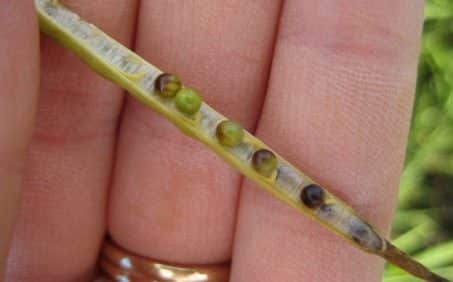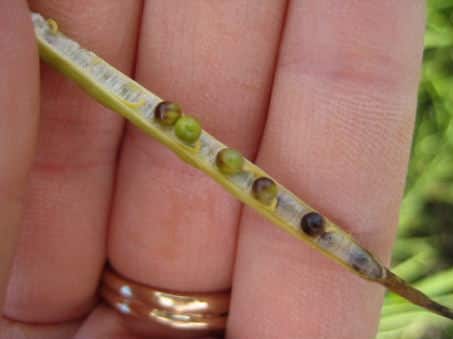The ideal swath timing is when 60% of seeds on the main stem are showing some colour change from green to brown. Colour change is considered any amount of yellowing or browning on the seed. To determine ideal swath timing, fields need to be walked and pods need to be cracked – it is 60% seed colour change not pod colour change.
The swath decision becomes more difficult in crops with plants at multiple stages of growth. For example, if some plants are at 60% seed colour change (SCC) on the main stem and other plants are still flowering, growers may want to hold off on swathing. Or if plants are large with many secondary branches due to low plant density, the main stem may be at 60% SCC, but seeds in side branches are still mushy and green. These seeds would wither up and amount to nothing if the crop is swathed at 60% SCC on the main stem. Growers need to determine where the bulk of the yield is located and determine the best time to swath. Generally, with good plant stands, the majority of the yield is found on the main stem with less on the side branches. If there is a risk of shattering losses on the main stem while waiting for the side branches, growers need to decide which is the least risk for the greatest reward.
The decision requires an assessment of the field, and a look at the calendar.
—Check the whole field. If half the plants are ready and half are just beginning seed color change, growers may want to hold off on swathing. By waiting 3 or 4 days, there is minimal risk of frost damage for riper parts of the field and a huge potential benefit for later parts if frost doesn’t occur.
—It’s just mid-August. The risk of frost is relatively low at this time, so multi-stage fields with some plants ready to swath can be left a few days for SCC to begin on side branches.
—If the field has distinct late and early parts, the two parts could be swathed at different times. When assessing stage for swathing, ignore plants that are prematurely ripened due to diseases like sclerotinia, blackleg and clubroot. However, determine the actual cause of the premature ripening so appropriate changes can be planned such as selecting resistant varieties in the future.
—There is no “perfect” time to swath uneven crops. Choose based on the best time for the majority of plants in the field with the least negative impact possible on the rest.
—If there are large acreages to swath, it is unrealistic to swath everything at 60% SCC. If growers need to swath earlier for logistics, it should be no earlier than 30 to 40% SCC to capture as much yield as possible.
Click here to list to a podcast of Canola Council Agronomist Angela Brackenreed discussing how to determine when to swath based on seed colour change.


